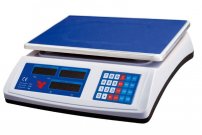Electronic digital balance

There's something so commonplace about a weighing device that it's easy to forget its deeper significance. As the slightly skewed spring scale hanging around the produce aisle reminds us, the scale has long served humans as the chief arbiter of commerce, the sine qua non of shipping and the utility player of the pharmaceutical bench. From the smallest, most fine-tuned laboratory balance to the 10-by-120-foot (3-by-37-meter) pit-and-girder monsters that weigh train cars and tractor-trailers, scales make modern life possible.
Scales - or, more specifically, balances - weighed heavily on the minds of ancient builders, inventors and economic advisers. Small balance weights dating back to the early fourth millennium B.C. provide some of the first hints of mankind's evolving grasp of numbers. The most basic surviving balance scale in Egypt predates the dynastic period, placing its construction at earlier than 3000 B.C. Like us, the ancient Egyptians applied scales both in trade and in assaying ores and alloys [sources: Encyclopaedia Britannica; Petruso].
Balances, which weigh an object by matching it against one or more reference weights, have a delicate touch and are still used in laboratories. Scales use somewhat different physical principles and mechanical components to measure weight and other forces (weight is simply the force on an object due to gravity). Spring scales, for example, measure weight using Hooke's law, which relates force (weight) to the stretching or compression of a spring made from a given material.
Not all scales use springs, but all measure weight using mechanical components. So, mechanical and digital scales differ only in how they display weight - mechanically or electronically. In the latter case, the scale employs an analog-to-digital converter that translates the continuous readout data from the scale into discrete digital information, much in the way that a CD or MP3 encoding scheme digitizes the waveforms of music.
Generally speaking, digital scales require less expertise to use than those with mechanical readouts, and are capable of higher precision and faster processing. Still, the capabilities of specific devices may vary, particularly when the weights are measured in tons [sources: Camarda; Cox; Crowley].
"It depends, " says Derrick Mashaney, director of product development at Fairbanks Scales Inc., which specializes in large industrial scales. "Several master scales are mechanical. They're tweaked to be so extremely accurate that there is nothing out there that compares to them."
Just as a roadside carjack might lift a car via mechanical advantage - the leverage of a handle or the inclined plane of a screw - while a mechanic's hoist might use hydraulic pressure, different scales weigh objects using a variety of operational principles, like hydraulics, pneumatics or bending beams.
Related posts:

 One of the more cost-effective measurements in a paper mill is that which monitors the flow of pulp stock into the head box of the paper machine. The stock level…
One of the more cost-effective measurements in a paper mill is that which monitors the flow of pulp stock into the head box of the paper machine. The stock level… Overview Marel Marine Scales are specifically designed for use on board fishing vessels and factory trawlers. This cost-effective series of scales ranges from the…
Overview Marel Marine Scales are specifically designed for use on board fishing vessels and factory trawlers. This cost-effective series of scales ranges from the… How long to air fry french fries what does fafsa stand for What does it mean when ypu use alocohol and the tips of your fingers turn white Who raps bitches aint…
How long to air fry french fries what does fafsa stand for What does it mean when ypu use alocohol and the tips of your fingers turn white Who raps bitches aint… Globe s portion control scales can be used in a wide spectrum of applications from delis and pizza parlors, to bakeries and restaurants, or any establishment where…
Globe s portion control scales can be used in a wide spectrum of applications from delis and pizza parlors, to bakeries and restaurants, or any establishment where… How to get bubbles out of screen protector? Totally add add tips and tricks how to eat an elephant list What are all the tricks you can have in trickerion board…
How to get bubbles out of screen protector? Totally add add tips and tricks how to eat an elephant list What are all the tricks you can have in trickerion board…